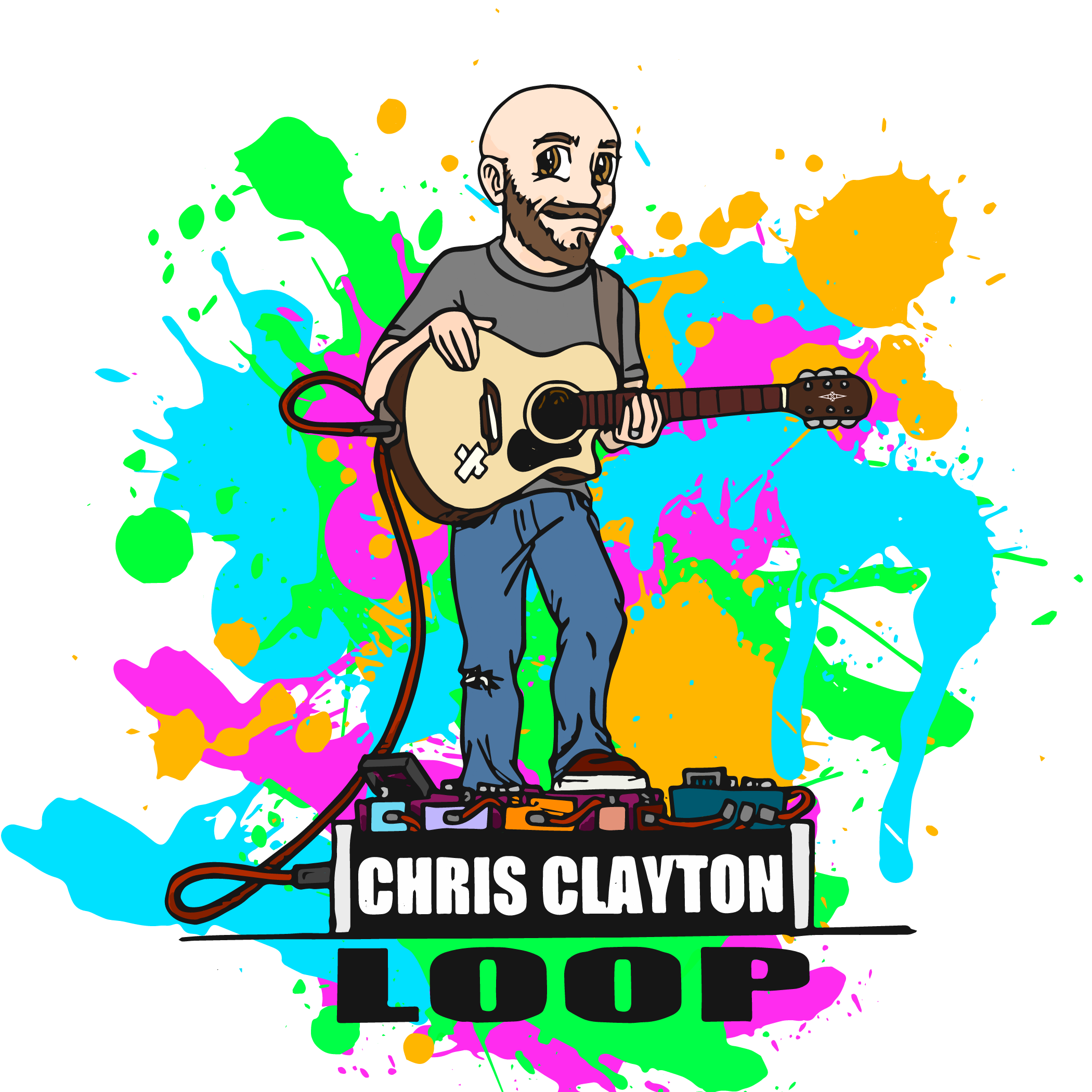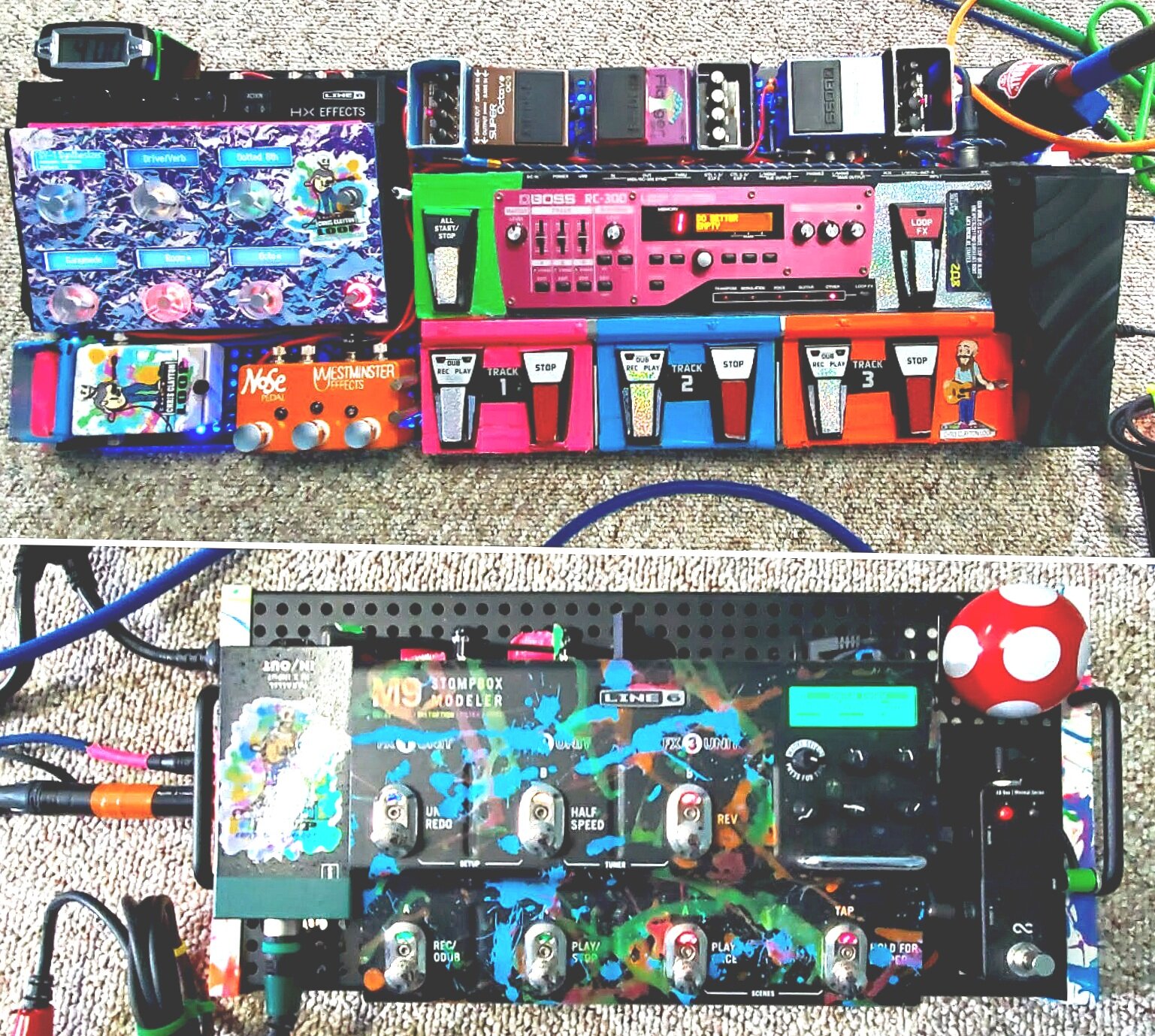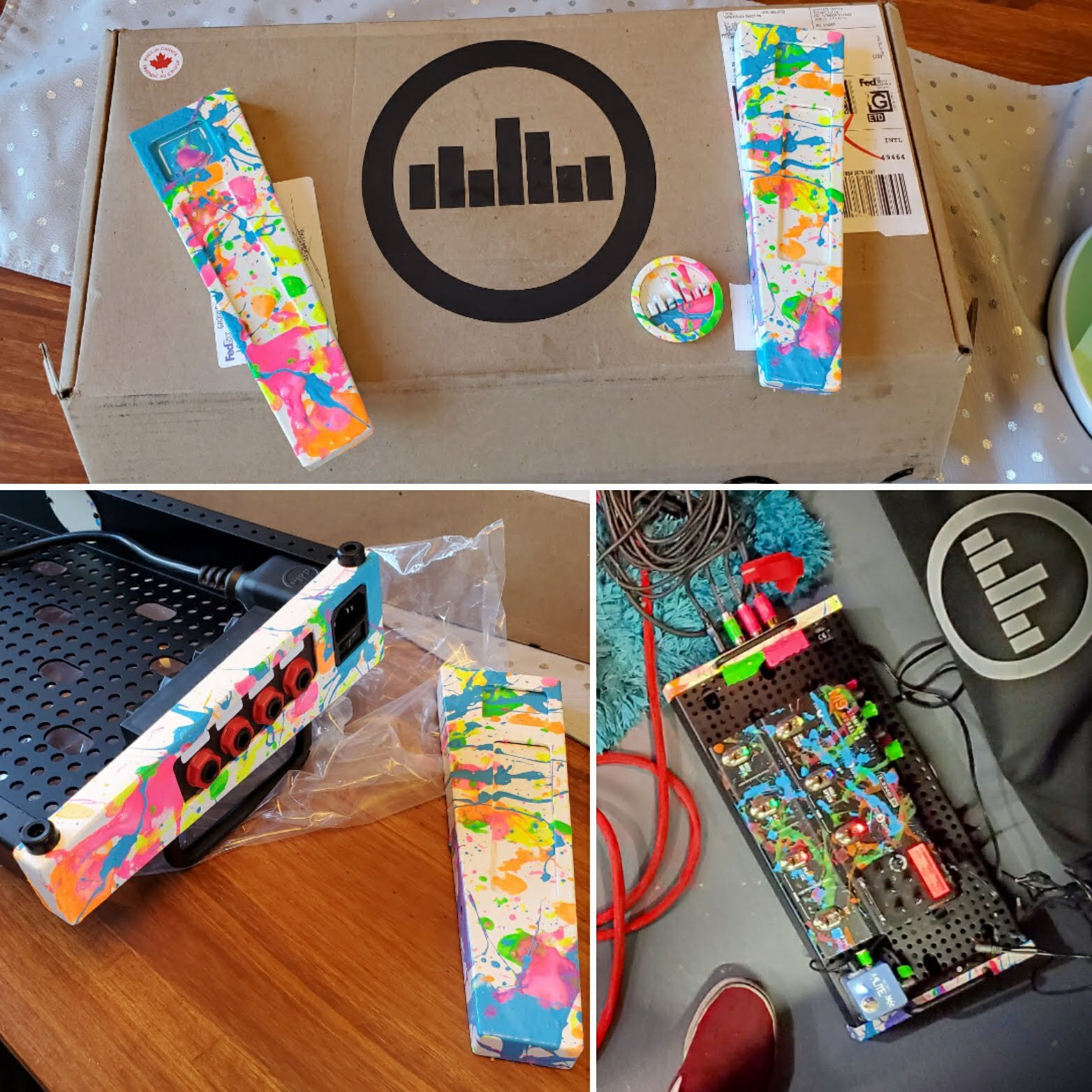^^^latest version of the board^^^
The current setup explained…
Scroll down to travel back through the phases of the pedalboard build
Guitar signal: From the picture above, you see that the guitar cable has a red and a white side. Those both run separately through the board. Check out my guitar page for more information about those two signals, but for now Red = Pickup and White = Percussion. The instrument cable also has a headphone extension with it (3 cables in 1) that i plug my headphones into, and can either plug it direct into the pedalboard if i just want to listen to guitar (if I’m noodling around and not running through speakers) or run back to my mix board to listen to the entire mix (which is usually how i play shows).
The 4 I/O patch bay on the side is set up for Red, White, Black (headphones), and Blue (output). There is also a XLR output incase that is needed (there is a DI box underneath running a second output), and a XLR input for the Loop Station microphone.
The Red runs through a buffer (underneath), then up to the Boss OC-3 (set to the Polyphonic setting, only Octaving down the low E string). The OC-3 splits guitar signal and octave signal, the octave signal runs down to the Westminster/NosePedal orange box, while the guitar signal runs to the Line 6 HX Effects. From the HX, the guitar runs to the Boss DD-6 (set on Warp), then to the Boss BF-2, and then also to the Westminster/NosePedal orange box. Side note: the new Boss SY-1 runs through the effects loop of the HX, so that I didn’t have to rewire the board again and also running it through the HX lets me move the order around with all the effects I use in each preset. That also means i can swap it out easily, anytime.
The White also runs through a buffer (also underneath), and then goes straight to the Westminster/NosePedal orange box.
Westminster/NosePedal orange box, is essentially an ABC pedal. 3 signals run in, and one signal out. Toggling each signal independently, or all at once. So i can mix my guitar signal, percussion signal, and octave (bass) signal with my feet while playing. The output signal runs from the orange box, to the Boss RC-300 Loop Station input.
My friend, Cody, at Westminster (pedal company) and NosePedal (utility pedals and repairs) has helped me out with a number of specific, one-off, pedals that I needed at certain periods of this odyssey. From expression pedals, mute pedals, DI’s, signal mixers, etc. Definitely recommend checking him out.
The RC-600 Loop Station is the heart of the pedalboard, and also the newest addition. 6 track looping, on-board effects, and even more versatility than the previous RC-300. Even with all the other loopers out there, i prefer this for the functionality and simplicity. Microphone input and AUX input as well. I will occasionally plug my cellphone keyboard in to add more sounds to loops. And like I said before, the 2 outputs run either 1/4” (Blue cable) or through a DI box for XLR.
Microphone: I have my microphone mounted on the guitar pedalboard. The cable runs to the side of the pedalboard, i use the Whirlwind IMP-Z to change the impedance to run through the guitar pedal. The signal runs through the Line 6 M9, and then to a BOSS TU-3 Tuner. “Bypass" runs back to the side module and goes to the mix board, thats for main vocals. “Output" runs from the pedal to the DI box. Then from that I run a short XLR to the guitar pedalboard, that runs into the RC-600 Loop Station.
This is all done so my vocals are constantly running to the mixer, and when I turn the Tuner off, that engages the “Output" channel and that runs to my Loop Station. That way im always sending the same vocals out to the house, and only toggling the loop vocals on/off. And if i dont want guitar interference while looping vocals, I can toggle all the signals ‘off’ on the Westminster/NosePedal.
Here are direct views of each board at the end of 2021.
After quite some miles on the setup as it was before, i made another purchase, the new Boss SY-1. As well as an AB switcher for my microphone board. I also fashioned the mic stand to mount directly on the pedalboard. I went down to only using one microphone, and switching the signal path from main to loop station. This is pretty much how it stands now.
Since i removed the Line 6 M9, i thought it would be fun to try using it for vocals. Being able to add reverbs, delays, and other effects would be fun for me and hopefully the audience. I ordered another Temple Audio board, their Solo 18. I aslo did my “puppy patter splatter” paint job to match. And wired up for 2 microphones, using the Nose Mute to toggle on and off my looping mic.
Reorganizing pedals and signal chain.
Trying to clean up the layout of pedals and patch cables, and tetris this new HX in just right. I swapped out to 3 Monkeys Solderless which had the smallest size plug heads i could find. That way the Boss pedals above the Loop Station could fit as tightly up against it. I was able to get all the pedals tightly packed together, which is good because I’m only using the soft bag to carry the board in. But that keeps weight down.
A big upgrade to the HX Effects.
I had been saving up, and finally bit the bullet on the Line 6 HX Effects. This was to remove a few more pedals, because the HX has so much more capabilities. I did have to spend time again to dial in all my effects to replace the M9 and a couple others. One of my big selling points was that i could run 2 separate signals (Left and Right) and each signal could have their own effects. So i was running the guitar signal and percussion signal both through the HX, each using their own effects.
I then had to put my touch on it, so I covered the face of it with an awesome pattern i found. This time it is not as permanent as the splatter on the M9.
Downsizing to the Temple Audio Duo 34:
As the family was growing (having twins) i wasn’t able to transport that huge pedalboard anymore. the Trio 43 only fit across the backseat, not the hatch, and the backseat was now occupied by 2 carseats. I looked around and did some measuring to find a smaller size board. Temple also has a pedalboard builder on their website, so i could shuffle around pedals to see what would fit. But this made me rethink my entire setup, and determine what was important and what wasn’t. You can see the size comparison in the top. I also got the idea to do a “puppy patter splatter” and graffitied the side panels (and a couple pedals too). This took some time to get everything setup and dialed in, for sure, but it sure was fun. This was a great size to work with as well. No long stretches while i tap dance, or struggling to find enough room to use it.
Discovering Temple Audio and their Trio 43 pedalboard:
I was running out of space with all the gear i wanted, and i needed a board that i could stack the Line6 DL-4 above the Boss RC-300. This was the only stock size board i could find that was tall enough to not have anything overhanging. You can see the shuffling around of pedals, while i was adding more pedals. Also when i first transferred to the Temple board, this pedalboard filled up with pedals was just about as heavy as the previous board without any pedals.
That obviously changed as I added more pedals, and thats when i had a “live in” flight case (with wheels). I loved having such a creative platform, it was just a little back breaking lugging in and out of open mic nights.
In the beginning:
Started the pedalboard out of necessity, just a home for the few pedals I had, and the footswitch to my amplifier. Trading a few pedals on and off to suit what i needed, and then starting my loop pedal interest with the Boss RC-2. That loop pedal was perfect for what i needed for years. And i can still use it for most of the songs no problem, but i knew i wanted to looping experience to grow and help with writing songs. That's when I bit the bullet and bought the RC-300 from Boss. It was way more than I needed, and it still is, bit after shopping around it did a few things I didn't find anywhere else. I still need to sit down for a few days and experiment with more capabilities, but I know how to make it work for what I need. After I got that I had to rearrange everything a couple times to fit everything I needed.the center picture is the final outcome, had to put a few pedals on risers to work. I also found a company called NosePedal and Westminster that will play a role later on.







